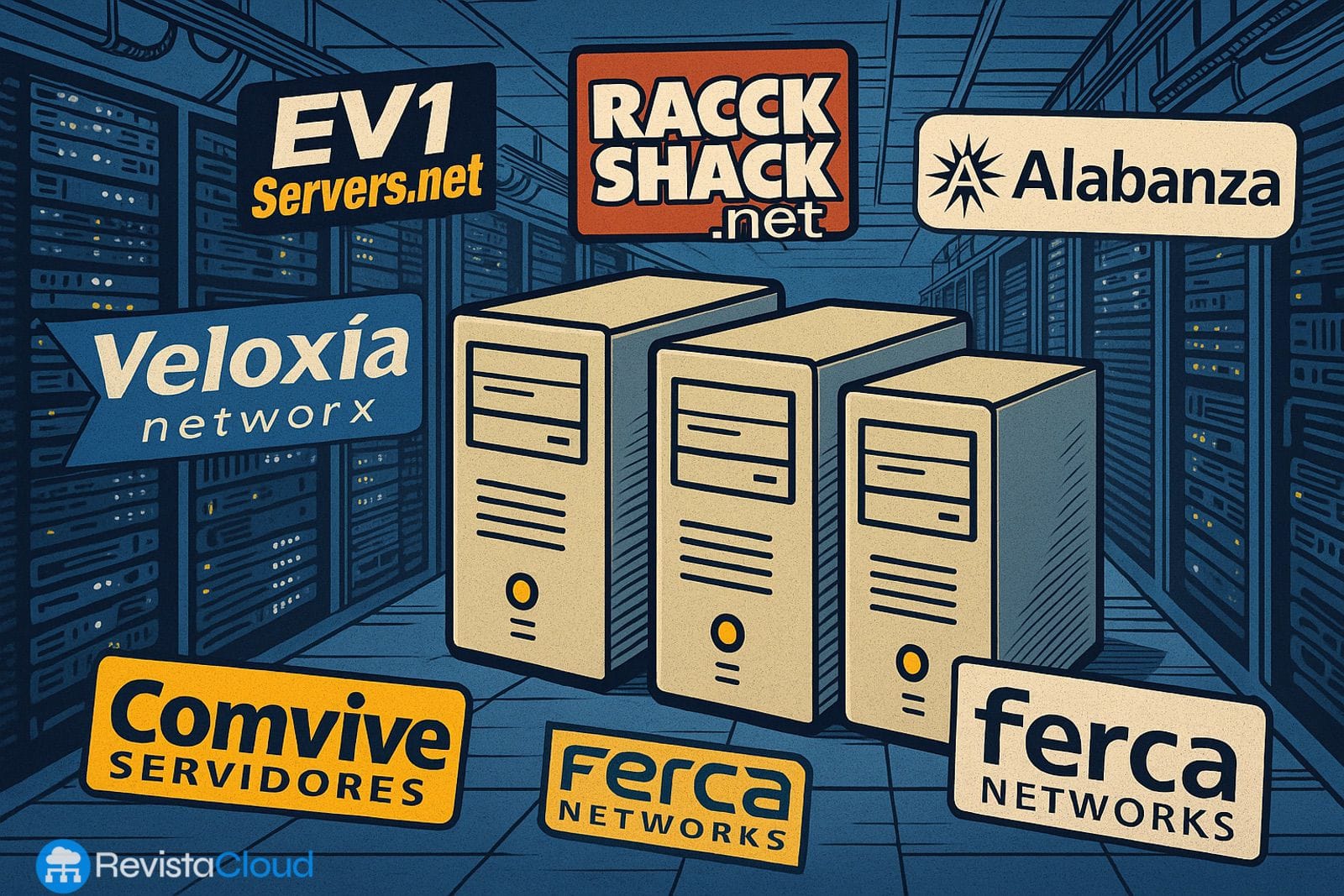Before the cloud, the edge, and the hyperscalers, a generation of companies existed that democratized digital infrastructure with dedicated servers at revolutionary prices. In the U.S. and Spain, names like EV1Servers, RackShack, DigitalNation, Alabanza, Ferca Networks, Veloxia Network, and Comvive defined the birth of the mass hosting era.
When Hosting Was Hardware: The Context of the Early 2000s
During the early years of the 21st century, most websites lived on shared servers. The “shared hosting” model dominated due to its low price, but suffered from limited resources, little flexibility, and scant independence for developers or businesses. It was a pre-cloud era where having a dedicated server—a complete physical machine—was synonymous with technological power and autonomy.
It was then that companies emerged offering something unprecedented: dedicated servers at affordable prices with no long-term contracts. Often, for just $99 or euros a month, any SME or developer could have their own complete environment to host websites, emails, or applications.
U.S.: The Revolution from Houston and Baltimore
RackShack / EV1Servers
Founded by Robert Marsh in Houston, Texas, RackShack was one of the first to offer dedicated servers for $99 a month in 2001. Automation, basic control panels, and rapid provisioning defined its success. Later, the brand solidified as EV1Servers.net, which at its peak managed over 20,000 physical servers.
In 2005, it was acquired by The Planet, which would later be absorbed by SoftLayer and subsequently by IBM.
DigitalNation (1997)
A predecessor in the scalable hosting model, DigitalNation offered colocation and dedicated servers since the late ’90s. It was acquired by Verio in 2000 and later became part of NTT Communications.
ServerMatrix (2003)
Launched by The Planet, ServerMatrix targeted technical users and resellers. It offered custom configurations, robust connectivity, and 24/7 support, all at competitive prices.
Alabanza (1995)
Based in Baltimore, Alabanza Corporation was an overlooked pioneer. In the mid to late ’90s, it not only offered dedicated hosting but also developed its own control panel to manage customer accounts, something innovative for the time. This software was a precursor to many current panels (like WHM/cPanel) and was used by hundreds of resellers in the U.S. and Europe.
Spain: The Awakening of Local Infrastructure
Ferca Networks (Herencia, Ciudad Real, 1998)
Founded in 1998, Ferca Networks, created by one of the current founders of Stackscale (Grupo Aire), David Carrero, was one of the first Spanish providers to offer dedicated servers and professional hosting. Its offering included root access, dedicated IPs, guaranteed bandwidth, and panels like Plesk or cPanel. Ferca was later acquired by acens and subsequently integrated into the Telefónica ecosystem.
Veloxia Network (Elda, Alicante, 2001)
Veloxia Network was one of the most active companies in the Spanish hosting landscape at the beginning of the millennium, created by David Sánchez, Javier Primo, and Vicente Hernández. It specialized in dedicated servers and housing services and was a pioneer in offering SLAs and managed services at a time when most companies only provided infrastructure without support. Veloxia was also acquired by acens around the same time as Ferca.
Comvive Servidores (Sevilla, 2001)
Founded in 2001, Comvive, created by Daniel Salamanca and Fernando Cerrato, established itself as one of the few hosting providers with its own infrastructure in Spain. They focused from the beginning on dedicated servers, colocation, DNS services, and later cloud offerings. What set them apart was their specialized technical support and direct client interaction, highly valued among developers and businesses. Today, Comvive continues to operate as one of the longest-standing independent companies in the sector.
Technical Comparison: Then and Now
| Feature | Dedicated Servers (2000–2005) | Current Infrastructure (Cloud and Bare-Metal) |
|---|---|---|
| CPU Type | Pentium III/IV, Athlon, single-core Xeon | Xeon Scalable, EPYC, ARM64 |
| Typical RAM | 256 MB – 1 GB DDR | 32 GB – 1 TB DDR5 |
| Control Panels | Proprietary, CPanel, Plesk, Alabanza | WHM/cPanel, Proxmox, cloud portals |
| Delivery Time | 24–72 hours | Instant (cloud) or 2–6 hours (automated bare-metal) |
| Virtualization | Not available or manual (chroot, jail) | Standard (KVM, Xen, VMware, LXC) |
| Scalability | Manual (changing physical machine) | Dynamic (horizontal/vertical auto-scaling) |
| Security | Software firewall, IPtables | Micro-segmentation, IPS, automatic DDoS, RPO 0 backups |
Legacy
These hosting pioneers offered something that until then was unthinkable: infrastructure for all. They facilitated the creation of startups, forums, download platforms, online stores, and nascent social networks. At a time when AWS didn’t even exist, RackShack, Ferca Networks, and Comvive were “the cloud” for many entrepreneurs.
Today, although much of the sector has migrated towards cloud architectures, dedicated servers remain essential for high-load tasks, consistent performance, or privacy needs.
The story of dedicated hosting is the story of how the internet became decentralized, moving from the hands of large corporations to empower SMEs, developers, and communities. From Baltimore to Seville, through Houston, Herencia (Ciudad Real), and Valencia, these companies laid the groundwork for modern infrastructure. Many have disappeared, others have been absorbed, while new ones like Stackscale have emerged, and some like Comvive continue to endure. But they all shared a vision: that the internet should be accessible to everyone, server by server.

